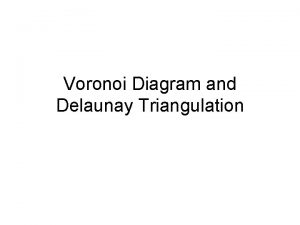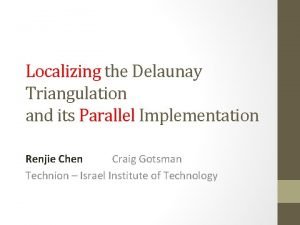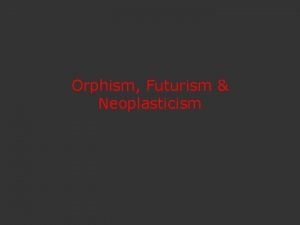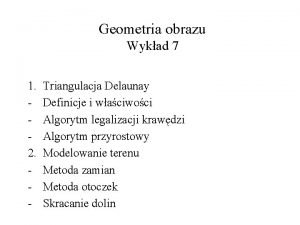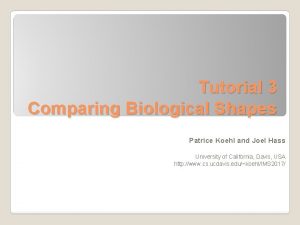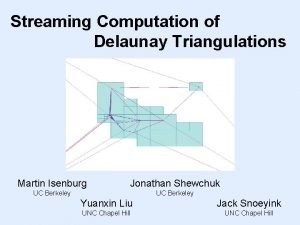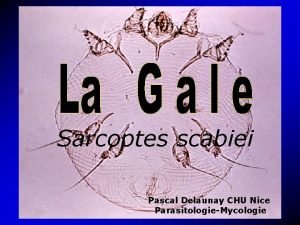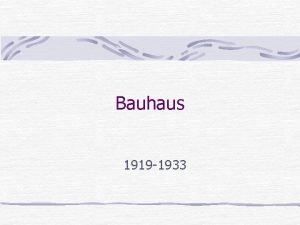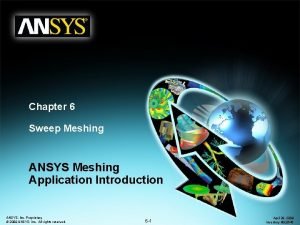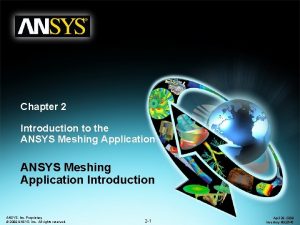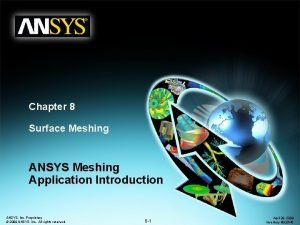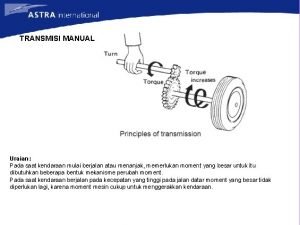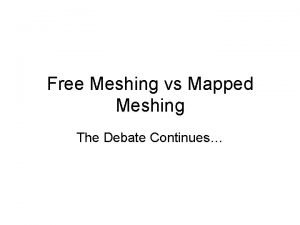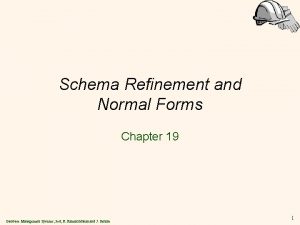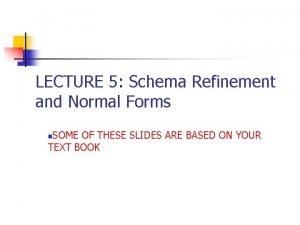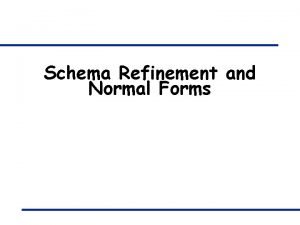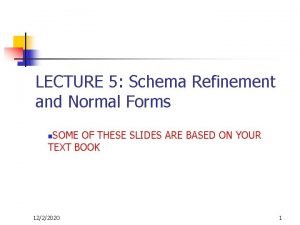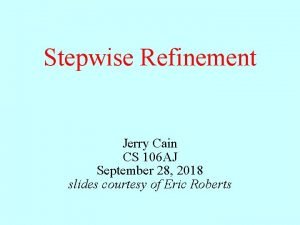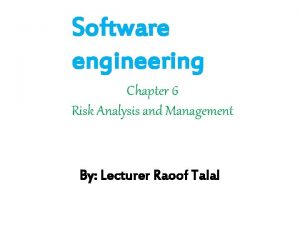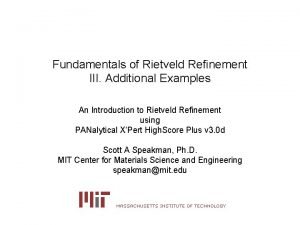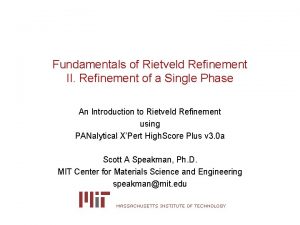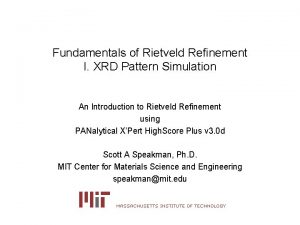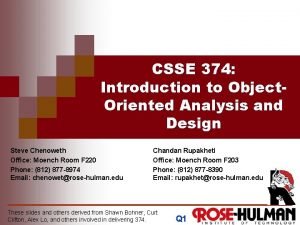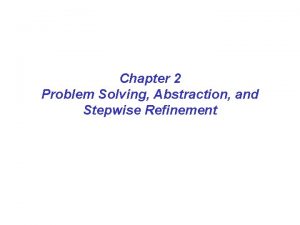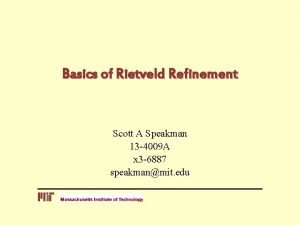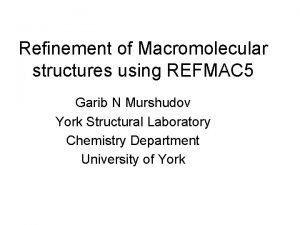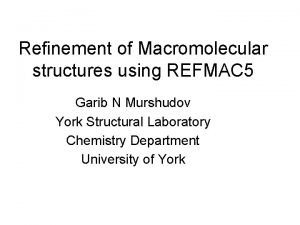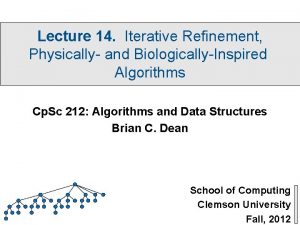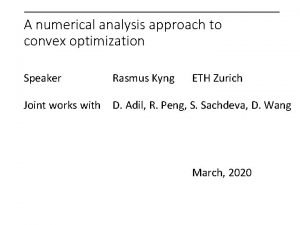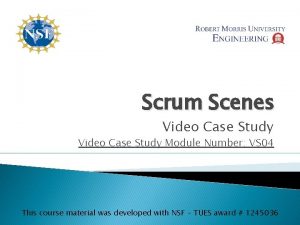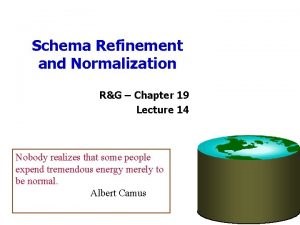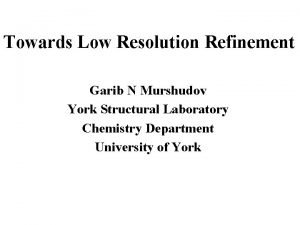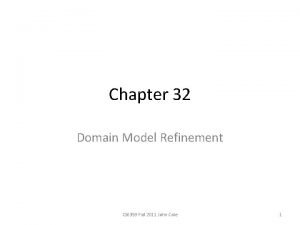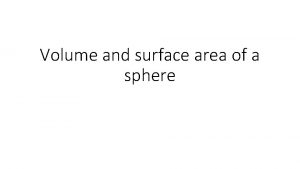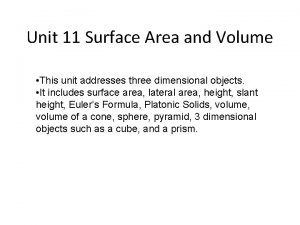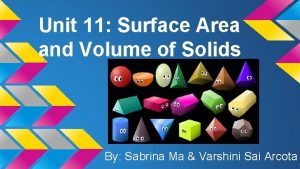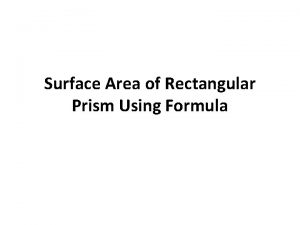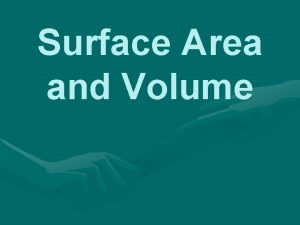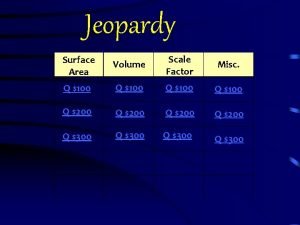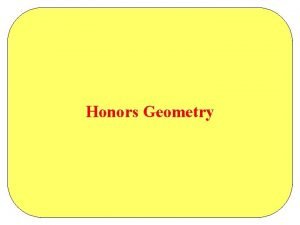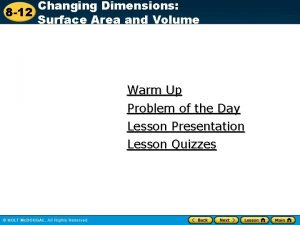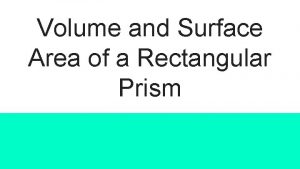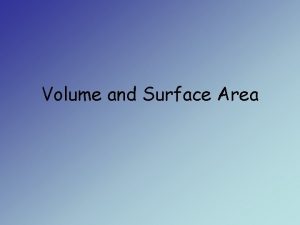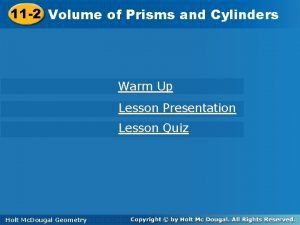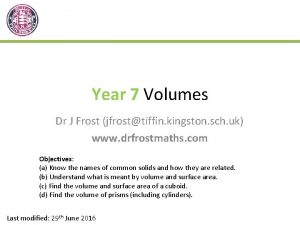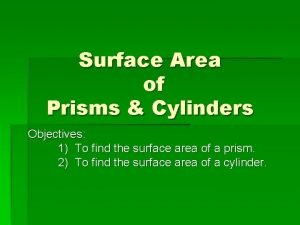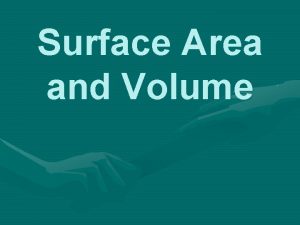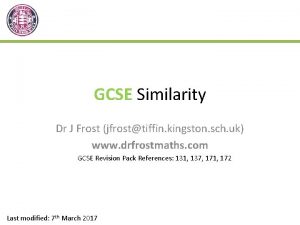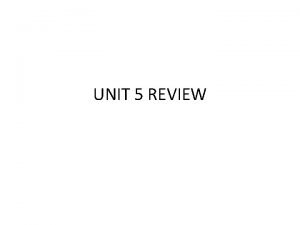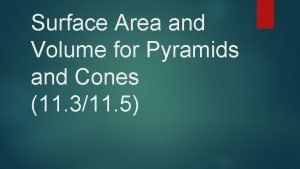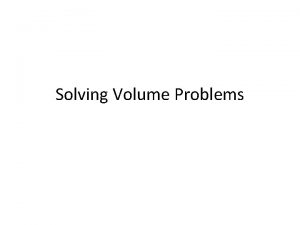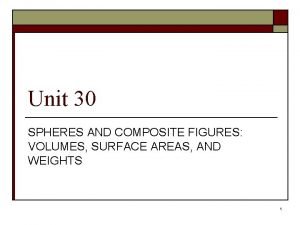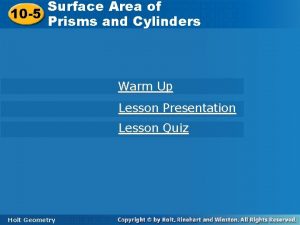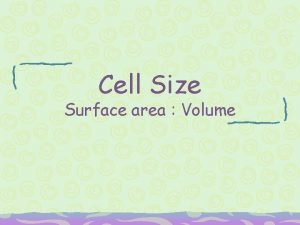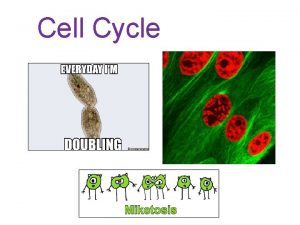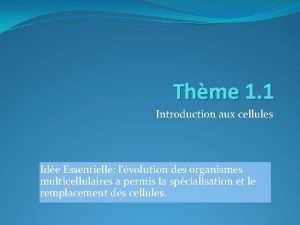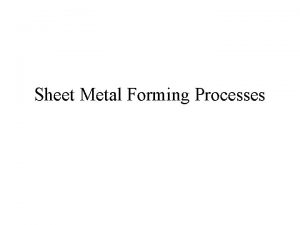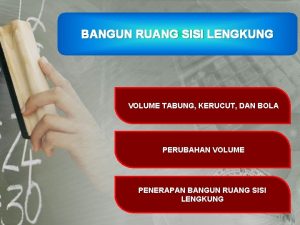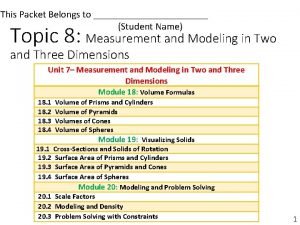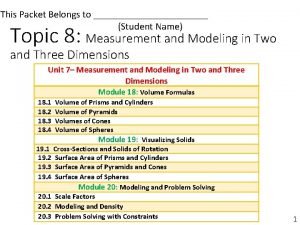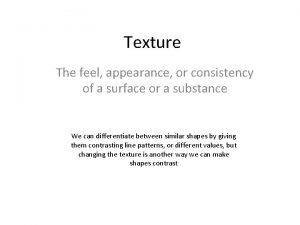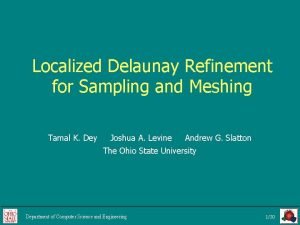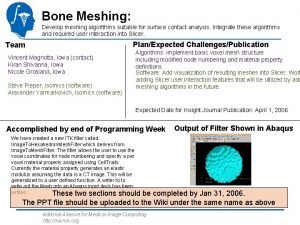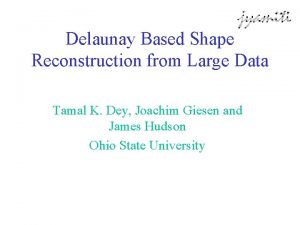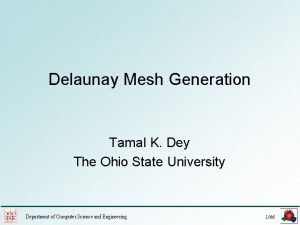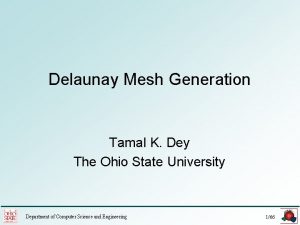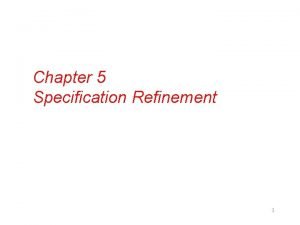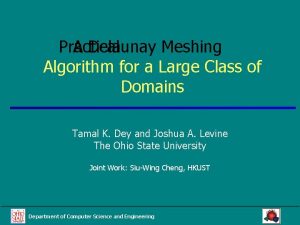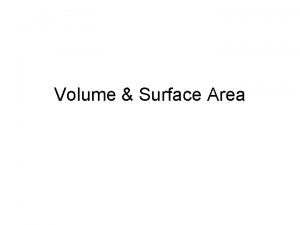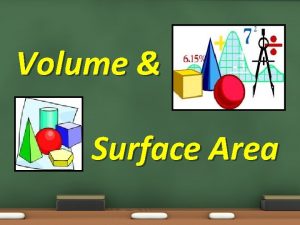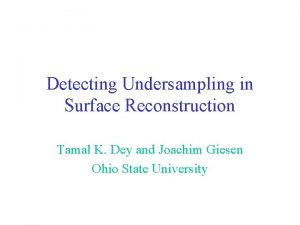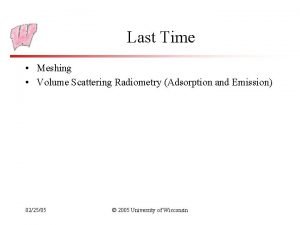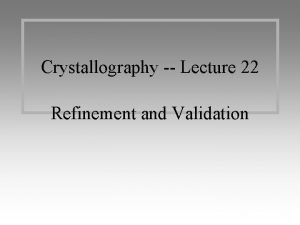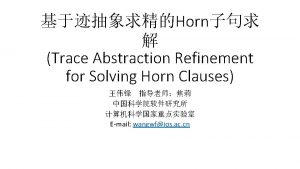Surface and Volume Meshing with Delaunay Refinement Tamal










![Polyhedral Volumes and Surface [Shewchuk 98] Input PLC • Final Mesh No input angle Polyhedral Volumes and Surface [Shewchuk 98] Input PLC • Final Mesh No input angle](https://slidetodoc.com/presentation_image_h/33ba9d84ef741f842f7d914f9494a715/image-11.jpg)








![Sharp vertex protection SOS-split [Cohen-Steiner et al. 02] Department of Computer and Information Science Sharp vertex protection SOS-split [Cohen-Steiner et al. 02] Department of Computer and Information Science](https://slidetodoc.com/presentation_image_h/33ba9d84ef741f842f7d914f9494a715/image-20.jpg)








![Dihedral Angle Distribution Model Dihedral Angle [0 -5] (5 -10] (10 -15] (15 -30] Dihedral Angle Distribution Model Dihedral Angle [0 -5] (5 -10] (10 -15] (15 -30]](https://slidetodoc.com/presentation_image_h/33ba9d84ef741f842f7d914f9494a715/image-29.jpg)







![No Sliver • • Weight property[ ]: each weight u N(u) Ratio property [ No Sliver • • Weight property[ ]: each weight u N(u) Ratio property [](https://slidetodoc.com/presentation_image_h/33ba9d84ef741f842f7d914f9494a715/image-37.jpg)








![Local Feature Size and ε-sample [ABE 98] f(x) Medial axis f(x) is the distance Local Feature Size and ε-sample [ABE 98] f(x) Medial axis f(x) is the distance](https://slidetodoc.com/presentation_image_h/33ba9d84ef741f842f7d914f9494a715/image-46.jpg)























![Polygonal surfaces [Dey-Ray 05] Input: Polygonized surface G approximating. Department of Computer and Information Polygonal surfaces [Dey-Ray 05] Input: Polygonized surface G approximating. Department of Computer and Information](https://slidetodoc.com/presentation_image_h/33ba9d84ef741f842f7d914f9494a715/image-70.jpg)







![Bounding Conditions Condition 1: and . Condition 2: [Amenta, Choi, Dey, Leekha ‘ 02] Bounding Conditions Condition 1: and . Condition 2: [Amenta, Choi, Dey, Leekha ‘ 02]](https://slidetodoc.com/presentation_image_h/33ba9d84ef741f842f7d914f9494a715/image-78.jpg)










- Slides: 88

Surface and Volume Meshing with Delaunay Refinement Tamal K. Dey The Ohio State University

Polyhedral Volumes and Surface Input PLC • Final Mesh Qual. Mesh based on Cheng-Dey-Ramos-Ray 04 (solved small angle problem effectively) Department of Computer and Information Science 2/52

Implicit surface F: R 3 => R, Σ = F-1(0) Department of Computer and Information Science 3/52

Polygonal surface Department of Computer and Information Science 4/52

Voronoi/Delaunay Department of Computer and Information Science 5/52

Basics of Delaunay Refinement • • • Chew 89, Ruppert 95 Maintain a Delaunay triangulation of the current set of vertices. If some property is not satisfied by the current triangulation, insert a new point which is locally farthest. Burden is on showing that the algorithm terminates (shown by packing argument). Department of Computer and Information Science 6/52

Delaunay refinement for quality • • R/l = 1/(2 sinθ)≥ 1/√ 3 Choose a constant > 1 if R/l is greater than this constant, insert the circumcenter. Department of Computer and Information Science 7/52

Delaunay Refinement for 2 D point sets R/l > 1. 0 l 30 degree R Department of Computer and Information Science 8/52

Local Feature Size • • Local feature size: radius of smallest ball that intersects two disjoint input elements. f(x) x Lipschitz property: Department of Computer and Information Science 9/52

Delaunay Refinement with Boundary x L R >f(x) Circumcenter of skinny triangle encroaching edge. Conforming but still not Gabriel Department of Computer and Information Science 10/52
![Polyhedral Volumes and Surface Shewchuk 98 Input PLC Final Mesh No input angle Polyhedral Volumes and Surface [Shewchuk 98] Input PLC • Final Mesh No input angle](https://slidetodoc.com/presentation_image_h/33ba9d84ef741f842f7d914f9494a715/image-11.jpg)
Polyhedral Volumes and Surface [Shewchuk 98] Input PLC • Final Mesh No input angle is less than 90 degree Department of Computer and Information Science 11/52

Quality of Tetrahedra …… Thin Flat Sliver radius-edge-ratio: Department of Computer and Information Science 12/52

Delaunay refinement for input conformity • • Diametric ball of a subsegment empty. If encroached by a point p, insert the midpoint. Subfacets: 2 D Delaunay triangles of vertices on a facet. If diametric ball of a subfacet encroached by a point p, insert the center. Department of Computer and Information Science 13/52

Refinement Steps • Compute Delaunay of vertices Do the splits in the following order: • Split encroached subsegments • Split encroached subfacets • Let c be the circumcenter of a skinny tetrahedron • • if c encroaches a subsegment or subfacet split it. Else insert c. Department of Computer and Information Science 14/52

Child-Parent and insertion radii > 2. 0 Department of Computer and Information Science 15/52

Polyhedral surface with any angle • • Small angles allowed Conforming : • • • Each input edge is the union of some mesh edges. Each input facet is the union of some mesh triangles. Quality guarantees. Department of Computer and Information Science 16/52

History • No quality guarantee • • Effective implementation [Shewchuk 00, Murphy et al. 00, Cohen-Steiner et al. 02]. Quality guarantee • [Cheng and Poon 03] • Complex. • • • Expensive. • • Protect input segments with orthogonal balls. Need to mesh spherical surfaces. Compute local feature/gap sizes at many points. [Cheng, Dey, Ramos and Ray 04] Department of Computer and Information Science 17/52

Main Result • • Quality Meshing for Polyhedra with Small Angles [Cheng, Dey, Ramos, Ray 04] A simpler Delaunay meshing algorithm • • • Local feature size needed only at the sharp vertices. No spherical surfaces to mesh. Quality Guarantees • • Most tetrahedra have bounded radius-edge ratio. Skinny tetrahedra will be provably close to the acute input angles. Department of Computer and Information Science 18/52

Small angle problem Department of Computer and Information Science 19/52
![Sharp vertex protection SOSsplit CohenSteiner et al 02 Department of Computer and Information Science Sharp vertex protection SOS-split [Cohen-Steiner et al. 02] Department of Computer and Information Science](https://slidetodoc.com/presentation_image_h/33ba9d84ef741f842f7d914f9494a715/image-20.jpg)
Sharp vertex protection SOS-split [Cohen-Steiner et al. 02] Department of Computer and Information Science 20/52

Subfacet Splitting • • Trick to stop indefinite splitting of subfacets in the presence of small angles is to split only the non-Delaunay subfacets. It can be shown that the circumradius of such a subfacet is large when it is split. Department of Computer and Information Science 21/52

Qual. Mesh Algorithm • • Protect sharp vertices Construct a Delaunay mesh. • Loop: • • • Split encroached subsegments and non-Delaunay subfacets. 2 -expansion of diametrical ball of sharp segments. (Radius = O( f(center) ) ) Refinement: • • Eliminate skinny triangle/tetrahedra Keep their circumcenters outside Department of Computer and Information Science We do not want to compute f (center) 22/52

Refinement Cont. . • • Split encroached subsegments and non. Delaunay subfacets. Let c be the circumcenter of a skinny triangle/tetrahedra. • • • If c lies inside the protecting ball of a sharp vertex or sharp subsegment then do nothing Else if c encroaches a subsegment or subfacet split it. Else insert c. Department of Computer and Information Science 23/52

Positions of skinny triangle/tet Department of Computer and Information Science 24/52

Summary of results • A simpler algorithm and an implementation. • • • Local feature size needed at only the sharp vertices. No spherical surfaces to mesh. Quality guarantees • • Most tetrahedra have bounded radius-edge ratio. Any skinny tetrahedron is at a distance from some sharp vertex or some point on a sharp edge. Department of Computer and Information Science 25/52

Results Department of Computer and Information Science 26/52

Results Department of Computer and Information Science 27/52

R/L Distribution Model Anchor Rail Wiper Cutter Simple Box Ushape Mesh Test 0. 6 -1. 4 1779 471 1851 1340 2580 764 806 Department of Computer and Information Science R/L 1. 4 -2. 2 1009 128 630 777 896 195 267 >2. 2 30 0 43 2 0 28/52
![Dihedral Angle Distribution Model Dihedral Angle 0 5 5 10 10 15 15 30 Dihedral Angle Distribution Model Dihedral Angle [0 -5] (5 -10] (10 -15] (15 -30]](https://slidetodoc.com/presentation_image_h/33ba9d84ef741f842f7d914f9494a715/image-29.jpg)
Dihedral Angle Distribution Model Dihedral Angle [0 -5] (5 -10] (10 -15] (15 -30] >30 Anchor 6 62 115 1006 2173 Rail 1 4 10 152 435 Wiper 7 37 50 695 1773 Cutter 11 20 82 635 1368 Simple Box 13 45 113 1124 2248 Ushape 2 15 25 267 620 Mesh Test 1 19 46 302 716 Department of Computer and Information Science 29/52

Meshing Polyhedra with Sliver Exudations Quality Meshing with Weighted Delaunay Refinement by Cheng-Dey 02

History • Bern, Eppstein, Gilbert 94 - Quadtree meshing (Non-Delaunay) • Cheng, Dey, Edelsbrunner, Facello, Teng 2000 - Silver exudation (no boundary) • Li, Teng 2001 - Silver exudation with boundary (randomized extending Chew) Department of Computer and Information Science 31/52

Weighted points and distances • • • Weighted point: Weighted distance: If Department of Computer and Information Science 32/52

Weighted Delaunay • Smallest orthospheres, orthocenters, orthoradius • Weighted Delaunay tetrahedra Department of Computer and Information Science 33/52

Silver Exudation • Delaunay refinement guarantees tetrahedra with bounded radiusedge-ratio • Vertices are pumped with weights Sliver Theorem [Cheng-Dey-Edelsbrunner-Facello-Teng]: Given a periodic point set V and a Delaunay triangulation of V with radius-edge ratio , there exists 0>0 and a weight assignment in [0, N(v)] for each vertex v in V such that ( ) 0 and ( )> 0 for each tetrahedron in the weighted Delaunay triangulation of V. Department of Computer and Information Science 34/52

QMESH algorithm 1. Compute the Delaunay triangulation of input vertices 2. Refine Rule 1: subsegment refinement Rule 2: subfacet refinement Rule 3: Tetrahedron refinement Rule 4: Weighted encroachment Check if weighted vertices encroach, if so refine. 3. Pump a vertex incident to silvers Department of Computer and Information Science 38/52

Guarantees • • Theorem (Termination): QMESH terminates with a graded mesh. Theorem (Conformity): No weighted-subsegment or weighted-subfacet is encroached upon the completion of QMESH Department of Computer and Information Science 41/52
![No Sliver Weight property each weight u Nu Ratio property No Sliver • • Weight property[ ]: each weight u N(u) Ratio property [](https://slidetodoc.com/presentation_image_h/33ba9d84ef741f842f7d914f9494a715/image-37.jpg)
No Sliver • • Weight property[ ]: each weight u N(u) Ratio property [ ]: orthoradius-edge-ratio is at most . • Lemma : Let V be a finite point set. Assume that Del V has ratio property [ ], has weight property [ ], and the orthocenter of each tetrahedron in Del lies inside Conv V. Then Del has ratio property [ ’] for some constant ’ depending on and • Lemma : Assume that Del V has ratio property [ ]. The lengths of any two adjacent edges in K(V) is within a constant factor v depending on and . • Lemma: Assume that Del V has ratio property [ ]. The degree of every vertex in K(V) is bounded by some constant depending on and . Department of Computer and Information Science 42/52

Size Optimality • Output vertices • Output tetrahedra • Any mesh of D with bounded aspect ratio must have tetrahedra • Theorem : The output size of QMESH is within a constant factor of the size of any mesh of bounded aspect ratio for the same domain. Department of Computer and Information Science 45/52

Example - Arm Input PLC Sliver Removal Department of Computer and Information Science Slivers Final Mesh 46/52

Example - Cap Input PLC Slivers Sliver Removal Final Mesh Department of Computer and Information Science 47/52

Example - Propellant Input PLC Sliver Removal Department of Computer and Information Science Slivers Final Mesh 49/52

Time Ratio=2. 2, Dihedral=3 , Factor=0. 5 Ratio=2. 2, Dihedral=5 , Factor=0. 5 # of slivers/min. dihedral angle after Skinny removal # of slivers/min. dihedral angle after Pumping Anchor 0 0 2 / 4. 95 0 Arm 10 / 0. 75 1 / 2. 9 26 / 0. 75 2 / 4. 66 Cap 6 / 0. 00 0 9 / 0. 0005 1 / 4. 59 Cavity 3 / 2. 31 0 6 / 2. 31 2 / 4. 52 Chair 1 / 1. 36 0 6 / 1. 36 2 / 4. 18 House 4 / 2. 02 1 / 2. 02 5 / 2. 02 1 / 2. 02 L-shape 0 0 Nalcola 0 0 2 / 4. 80 0 Our. House 0 0 1 / 4. 83 0 Propellant 9 / 1. 10 1 / 1. 97 33 / 1. 10 13 / 0. 87 Table 1 / 2. 99 0 2 / 2. 99 0 Tea. Table 0 0 Tfire 1 / 2. 11 0 2 / 2. 11 0 Wrench 24 / 0. 007 0 29 / 0. 007 1 / 4. 36 Department of Computer and Information Science 50/52

Extending sliver exudations to polyhedra with small angles Cheng-Dey-Ray 2005 (Meshing Roundtable 2005) • • • Carry on all steps for meshing polyhedra with small angles Add the sliver exudation step All tetrahedra except the ones near small angles have bounded aspect ratio. Department of Computer and Information Science 51/52

Delaunay Meshing for Implicit Surfaces Cheng-Dey-Ramos-Ray 04

Implicit surfaces • • Surface Σ is given by an implicit equation E(x, y, z)=0 Surface is smooth, compact, without any boundary Department of Computer and Information Science 53/52
![Local Feature Size and εsample ABE 98 fx Medial axis fx is the distance Local Feature Size and ε-sample [ABE 98] f(x) Medial axis f(x) is the distance](https://slidetodoc.com/presentation_image_h/33ba9d84ef741f842f7d914f9494a715/image-46.jpg)
Local Feature Size and ε-sample [ABE 98] f(x) Medial axis f(x) is the distance to medial axis Each x has a sample within f(x) distance Department of Computer and Information Science 54/52

Previous Work • • Chew 93: first Delaunay refinement for surfaces Cheng-Dey-Edelsbrunner-Sullivan 01: Skin surface meshing, Ensure topological ball property by feature size Boissonnat-Oudot 03: General implicit surfaces, Ensure TBP with local feature size Cheng-Dey-Ramos-Ray 04: General implicit surface, no feature size computation. Department of Computer and Information Science 55/52

Restricted Delaunay • Del Q|G : - Collection of Delaunay simplices whose corresponding dual Voronoi face intersects G. Department of Computer and Information Science 56/52

Delaunay Refinement (Chew) Department of Computer and Information Science 57/52

Topological Ball Property • • A -dimensional Voronoi face intersects G in a -dimensional ball. Theorem : [ES’ 97] The underlying space of the complex Del Q|G is homeomorphic to G if Vor Q has the topological ball property. Department of Computer and Information Science 58/52

Strategy • Topology Sampling : Grow a sample P by insertion until the Topological Ball Property is satisfied. Department of Computer and Information Science • Geometry Sampling: Quality. Smoothness. 59/52

Building Sample P 1. 2. If topological ball property is not satisfied insert a point p in P. Argue each point p is inserted > k f(p) away from all other points where k = 0. 06. -- Termination is guaranteed by 2. -- Topology is guaranteed by 1 and the termination. Department of Computer and Information Science 60/52

Voronoi Edge • Edge Lemma : If intersects Σ twice or more or tangentially, the farthest is > k f(p) away from all points. Department of Computer and Information Science 61/52

Voronoi Edge Lemma Justification Edge not parallel to normal Department of Computer and Information Science Almost normal edge 62/52

Voronoi Facet • • Facet Lemma I: If has a cycle of , then has a point > k f(p) away from all points. Facet Lemma II: If has two or more intervals, then s. t is > k f(p) away from all points. Department of Computer and Information Science 63/52

Voronoi Cells(>1 boundary) • Cell Lemma(>1 boundary): If is a manifold with two or more boundary cycles, then with > k f(p) away from all points. Department of Computer and Information Science 64/52

Voronoi Cells (0 -, 1 -boundary) Component inside ( taken care by critical pts. ) Department of Computer and Information Science Single boundary but not simply connected (Silhouette takes care) 65/52

Silhouette • • • Definition : Silhouette Lemma I: If has a single boundary and no pt with , then is a disk. Silhouette Lemma II: Any is > k f(p) away from all points. Department of Computer and Information Science 66/52

Silhouette Computation Department of Computer and Information Science 67/52

Voronoi Edge Test VEDGE ( ) If intersects Σ in two or more points, return the point furthest from. [Edge Lemma] Department of Computer and Information Science 69/52

Topological Disk Test Topo. Disk. K ( ) If is not a topological disk, return furthest point in edge-surface intersections. Department of Computer and Information Science 70/52

Voronoi Facet • Facet with more than one topological interval. v u F [Facet Lemma II] Department of Computer and Information Science 71/52

Voronoi Cell If is not a 2 -manifold with a single boundary then Topo. DISK () will take care of it. [Cell Lemma] Department of Computer and Information Science 73/52

Four Tests Contd. . • • Facet. Cycle( ): X: = Crit. Curve(Σ, F), then check if L intersects twice or more, return a point. [Facet Lemma I]. Silhouette(Vp ): X: =Crit. Silh(Σ, np, d). If , return a point from X otherwise see facet intersection. [Silhouette Lemma] Department of Computer and Information Science 75/52

Topology Sampling Topology(P): • If Vor. Edge, Topo. Disk, Facet. Cycle or Silhouette in order inserts a new point in P. Continue till no new point is inserted. Return P. Department of Computer and Information Science Topology Lemma: If P includes critical points of Σ and Topology(P) terminates then topological ball property is satisfied. • Distance Lemma I: Each inserted point p is > k f(p) away from all other points. 76/52

Geometry Sampling • • • Quality(P): If a triangle t has ρ(t) > (1+k)2 , insert where e = dual t. Smoothing(P): If two adjacent triangles make sharp edge, insert where e = dual t. Distance Lemma II: Each point is > k f(p) away from all other points. Department of Computer and Information Science 77/52

Algorithm DELMESH (Σ) Sample. Topology(P) Quality(P) Smooth(P) Continue till no point is added. Department of Computer and Information Science 78/52

Guarantees • • Output surface is homeomorphic to Σ. Each triangle has a guaranteed aspect ratio. • Smooth triangulation. • Size of P is asymptotically optimal. Department of Computer and Information Science 79/52

Results Department of Computer and Information Science 80/52
![Polygonal surfaces DeyRay 05 Input Polygonized surface G approximating Department of Computer and Information Polygonal surfaces [Dey-Ray 05] Input: Polygonized surface G approximating. Department of Computer and Information](https://slidetodoc.com/presentation_image_h/33ba9d84ef741f842f7d914f9494a715/image-70.jpg)
Polygonal surfaces [Dey-Ray 05] Input: Polygonized surface G approximating. Department of Computer and Information Science Output: A vertex set Q where each vertex lies on G and triangulation T 81/52

Non-Smoothness • • • Input G is piecewise-linear. Non-smoothness is a challenge. Delaunay refinement for polyhedron is not a viable choice. Department of Computer and Information Science 83/52

Delaunay refinement Department of Computer and Information Science 84/52

Assumptions • • • G approximates a smooth. G is -flat w. r. t. Many designed surfaces, reconstructed surfaces are -flat. Department of Computer and Information Science 85/52

Surf. Remesh 1. 2. 3. 4. 5. 6. 7. 8. 9. Initialize Q. Compute Vor Q. While (! Topology Recovered) VEDGE(). DISK(). FCYCLE(). VCELL(). End while Output Del Q|G. Department of Computer and Information Science 86/52

Voronoi Facet FCYCLE( ) If has a cycle, return the point in from. Department of Computer and Information Science furthest 87/52

Voronoi Cell VCELL( ) If Euler number return the point in furthest from. Single boundary but not 2 disk Department of Computer and Information Science 89/52

Extending results from smooth case If t=pqr has O(k)f(p) circumradius, ‹nt , np›=O(k) provided lengths > √(6δ) Big empty balls acting as medial balls Department of Computer and Information Science 90/52
![Bounding Conditions Condition 1 and Condition 2 Amenta Choi Dey Leekha 02 Bounding Conditions Condition 1: and . Condition 2: [Amenta, Choi, Dey, Leekha ‘ 02]](https://slidetodoc.com/presentation_image_h/33ba9d84ef741f842f7d914f9494a715/image-78.jpg)
Bounding Conditions Condition 1: and . Condition 2: [Amenta, Choi, Dey, Leekha ‘ 02] Department of Computer and Information Science 91/52

Sparse sampling and termination • Theorem: If and are sufficiently small, such that each intersection point is away from all other points. and Department of Computer and Information Science 92/52

Geometric Approximation • • : is the circumradius of the triangle t. : is the ratio of the circumradius to shortest edge length of t. Department of Computer and Information Science 93/52

Refinement GEOMRECOV( ) 1. For , if with insert the intersection point. TRIANGLE_QUAL( ) 1. For , if with insert the intersection point Department of Computer and Information Science 94/52

Remeshing reconstructed surfaces • • If P is an -sample, then the reconstructed surface with Delaunay methods (Cocone) are -flat for and. A simple algorithm for homeomorphic surface reconstruction [Amenta, Choi, Dey and Leekha ’ 02]. Department of Computer and Information Science 95/52

Termination • Theorem : If satisfies a bounding condition with respect to then it will terminate. and Department of Computer and Information Science 96/52

Results Department of Computer and Information Science 97/52

Results Department of Computer and Information Science 98/52

Results Department of Computer and Information Science 99/52

Meshing a equipotential surface data: courtesy to Alan Saalfeld V=21014, F=42024 V=2141, F=4278 Department of Computer and Information Science V=21507, F=42904 100/52

Conclusions • • • Different algorithms for Delaunay meshing of surfaces/volumes in different input forms All of them have theoretical guarantees The implementations can be downloaded from http: //www. cse. ohio-state. edu/~tamaldey/ Cocone: cocone. html Polyhedra: qualmesh. html Polygonal: surfremesh. html • • • Meshing a nonsmooth curved surface, remeshing polygonal surface approximating a non-smooth surface is a challenge. Anisotropic meshing [CDRW 05] CGAL acknowledgement: www. cgal. org Department of Computer and Information Science 101/52
 Voronoi diagram
Voronoi diagram Delaunay triangulation divide and conquer algorithm
Delaunay triangulation divide and conquer algorithm Futurism
Futurism Triangulacja delaunaya
Triangulacja delaunaya Delaunay triangulation
Delaunay triangulation Martin isenburg
Martin isenburg Pascal delaunay
Pascal delaunay Bauhaus poster
Bauhaus poster Where is jessica going answer
Where is jessica going answer What tourist places does tamal tell andy about
What tourist places does tamal tell andy about Tamal k dey
Tamal k dey Body sizing ansys
Body sizing ansys Ansys workbench mesh refinement
Ansys workbench mesh refinement Face meshing ansys
Face meshing ansys Momen yang besar dibutuhkan kendaraan pada saat ....
Momen yang besar dibutuhkan kendaraan pada saat .... Patch conforming method ansys
Patch conforming method ansys Mapped meshing
Mapped meshing T-tess triangle
T-tess triangle Schema refinement and normal forms
Schema refinement and normal forms Schema refinement and normal forms
Schema refinement and normal forms Schema refinement example
Schema refinement example Relation instance
Relation instance Surface area cylinders and prisms worksheet
Surface area cylinders and prisms worksheet Surface area of a cone
Surface area of a cone Triangle lateral surface area
Triangle lateral surface area Stepwise refinement python
Stepwise refinement python Risk refinement in software engineering
Risk refinement in software engineering Introduction to schema refinement
Introduction to schema refinement Fundamentals of rietveld refinement
Fundamentals of rietveld refinement Fundamentals of rietveld refinement
Fundamentals of rietveld refinement Fundamentals of rietveld refinement
Fundamentals of rietveld refinement Refinement
Refinement Stepwise refinement definition
Stepwise refinement definition Scott a speakman
Scott a speakman Jelly body refinement
Jelly body refinement Jelly body refinement
Jelly body refinement Iterative refinement
Iterative refinement Deeksha adil
Deeksha adil Backlog refinement
Backlog refinement Purpose of normalization or schema refinement
Purpose of normalization or schema refinement Jelly body refinement
Jelly body refinement Domain model refinement
Domain model refinement Domain model refinement
Domain model refinement Surface area of hemisphere and cylinder
Surface area of hemisphere and cylinder Volume of composite figures
Volume of composite figures Unit 11 volume and surface area
Unit 11 volume and surface area Rectangular prism surface area formula
Rectangular prism surface area formula Sp sa prism
Sp sa prism Surface area of pyramids and cones
Surface area of pyramids and cones The volume of pyramid
The volume of pyramid Volume and surface area of prisms maze worksheet
Volume and surface area of prisms maze worksheet Jeopardy surface area and volume
Jeopardy surface area and volume Area perimeter volume jeopardy
Area perimeter volume jeopardy Volume and surface area jeopardy
Volume and surface area jeopardy La=2πrh
La=2πrh Prism volume worksheet
Prism volume worksheet Volume of cuboid worksheet
Volume of cuboid worksheet Effects of changing dimensions on surface area and volume
Effects of changing dimensions on surface area and volume Rectangular prism template
Rectangular prism template Objectives of surface area and volume
Objectives of surface area and volume Prism vs pyramid
Prism vs pyramid 11-2 volume of prisms and cylinders
11-2 volume of prisms and cylinders Dr frost surface area
Dr frost surface area How to find the area of a hexagonal prism
How to find the area of a hexagonal prism Sa = 2(lw)+2(lh)+2(wh)
Sa = 2(lw)+2(lh)+2(wh) Similar shapes dr frost
Similar shapes dr frost Surface area formula
Surface area formula Surface area of pyramids and cones
Surface area of pyramids and cones A shipping carton is in the shape of a triangular prism
A shipping carton is in the shape of a triangular prism Volume and surface area of composite figures
Volume and surface area of composite figures Spin coat
Spin coat 11-2 surface areas of prisms and cylinders
11-2 surface areas of prisms and cylinders Reynold’s transport theorem
Reynold’s transport theorem Importance of surface area to volume ratio
Importance of surface area to volume ratio Control volume vs control surface
Control volume vs control surface Cell surface area definition
Cell surface area definition Surface area to volume ratio
Surface area to volume ratio Rapport surface volume cellule
Rapport surface volume cellule Surface area to volume ratio in bulk deformation process
Surface area to volume ratio in bulk deformation process Stroke volume definition
Stroke volume definition End-diastolic volume vs end-systolic volume
End-diastolic volume vs end-systolic volume Solute
Solute Lung capacity
Lung capacity Volume kerucut = .....x volume tabung *
Volume kerucut = .....x volume tabung * Define large volume parenterals
Define large volume parenterals Practice 11-3 surface areas of pyramids and cones
Practice 11-3 surface areas of pyramids and cones 19-3 surface area of pyramids and cones
19-3 surface area of pyramids and cones How to find surface area of composite figures
How to find surface area of composite figures The feel and appearance of a surface
The feel and appearance of a surface
